
Fluxes/Diarrhea and Related Illnesses Page Menu: 1 2 3 4 5 6 7 8 9 10 11 Next>>
Treating Fluxes in the Golden Age of Piracy, Page 5
Treatment of a Flux
"They [Bartholomew Roberts' pirates] continued their Course, and came to an Allowance of one single Mouthful of Water for 24 Hours... Others pined and wasted a little more Time in Fluxes and Apyrexies [illnesses without a fever], so that they dropped away daily: Those that sustain'd the Misery best,

Artist: Gustav Dore
Taken from Rime of the Ancient Mariner (1876)
were such as almost starved themselves, forbearing all sorts of Food, unless a Mouthful or two of Bread the whole Day, so that those who survived were as weak as it was possible for Men to be and alive." (Captain Charles Johnson, The General History of the Pyrates, 3rd Edition, p. 241-2)
Sea surgeon John Moyle gave an overview of how a cure of a flux should theoretically proceed.
[A flux] begins often with a Diarrhœa, and continuing long, turns to a Dysentery; especially if it be the reigning Distemper in the Ship or Place where you are.
This miserable Disease calls for these following Intentions.
First, To cast out the hot Cholerick Humors that so excoriate.
Secondly, To oppugn the malign quality that [i]s in the Blood.
Thirdly, To heal and consolidate the Ulcerations [inside of the intestines].
Fourthly, To fortifie the Heart, and Liver, and Stomach, and Natural Faculties, and restrain the Flux.1
He then goes into specifics, which will be detailed in the following pages under the appropriate sections. It is interesting to note that Moyle thought that a flux started as a diarrhea, which, if it wasn't stopped, became a dysentery. Today we know these are often two completely different diseases,
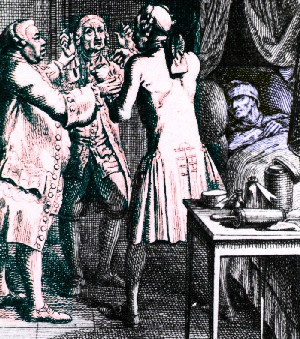
Patient Consultation, from Frontispiece of Medizinische
Annalen Fur Aerzte und Gesundheitliebende,
by Johann Gottlieb Frietze (1781)
but it reveals how poorly understood fluxes were. In fact, while some surgeons specifically delineate the treatment of a diarrhea as separate from dysentery, others do not. Since cures occasionally overlapped, we will look at them by treatment type, noting when the cure is specified for one or the other problem when the author has delineated this.
The prescribed cures for a flux tended to be all over the map, hinting at just how difficult period surgeons found this illness to cure.
We begin by looking at two humoral-based theories on curing a flux - those of bleeding a purging through the use of clysters or enemas. We then move on to some other cures in use at this time including binding foods, fumigation, bathing and exercise. We spend the majority of our time looking at medicinal cures, starting with non-type specified medicines and then going on to examine specific specifics including astringents, cathartics, cordials, Cockburn's electuary, topical treatments, opiates and finishing with another sort of humoral medicament - the purge. We'll finish with an example from physician Thomas Sydenham which uses several of the different curative agents in a single case study.
1 John Moyle, The Sea Chirurgeon, p. 172-3
Treatment of a Flux: Bleeding
Of all the cures proposed by period surgeons, bleeding seems one of the more unusual, given what we know today about dehydration. However, bleeding was something of a cure-all during much of medical history and so it was considered by many doctors for fluxes..

Galen of Pergamon, from De Morbo Attonito
Liber Unus, by Justus Cortnumm,
title page (1677)
All of the surgeons who recommend bleeding for a flux, suggest it only in the case of the Bloody Flux or dysentery. Physician William Cockburn explains that "no Body can imagine that bleeding can change the Sharpness of the Excrements, it is plainly no Cure of a Diarrhœa which is produced by stimulating Causes."1 He later comments that "bleeding is more peculiar to the Cure of a Dysentery, than can be alledged... Galen, Alex. Trallianus [Alexander of Tralles - a 5th/6th century Greek physician], Aetius [Aëtius of Amida, 5th/6th century Byzantine physician], and all other Physicians, have commended bleeding for curing a Dysentery."2 In fact, bleeding goes all the way back to Galen of Pergamon who did much to expand this cure's role in surgical treatments in his treatises published in the 2nd and 3rd centuries AD.
Fellow physician James White explained that in the case of a bloody flux with a fever, he "ordered Venesection to {12 ounces} [followed by restorative medicines]... The Fever in the Dysenteria was just sensible by the Pulse. I prescrib'd Venesection to {30 ounces}... But I repeated the bleeding in the first Distemper two or three times, if it did not cease after the Method I have spoke of, which succeeded well."3
Sea surgeon John Woodall noted that if the surgeon believed a flux "to proceed by fulnes of bloud
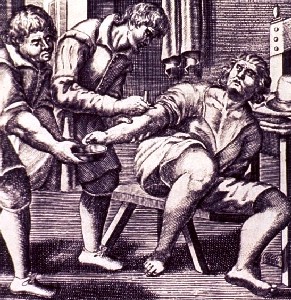
Bloodletting, from Nuova et Utlilssima Prattica di Tutto
Quello Ch'al Diligente Barbier s'Appartiene,
by Cintio Damato, p. 51 (1671)
or humours, to seeke the health of the Patients by sundry the most rationall and fittest evacuations; as namely, bleeding, purging, and slendernesse of diet"4. Fellow sea surgeon John Moyle likewise explained that it should be used on the 'Plethoric patients' or those who were of a sanguine temperament who were believed to have excess blood according to humoral theory. Moyle goes on to explain that "it is very proper to make Phlebotomy at first. I have often done it with good success, and it much annihilates the heat and sharpness of the Blood"5.
Both of them suggest using caution in this cure, however. Moyle advises that bleeding should "not be neglected, but celebrated before the Patient becomes too weak"6, suggesting that the surgeon must be cautious when bleeding during a dysentery. Woodall gives a much more strenuous warning, advising the surgeon to "doe it not without great discretion, and judgement; for the Patient weakned formerly with so terrible a sicknesse, and his spirits spent bleeding by a vaine, not advisedly done may suddainly overthrow and kill him"7.
While he may have been for bleeding in some cases, Woodall specifically advised against bleeding when "the disease proceedes from contagious and venomous aire, and is fierce, I holed it the safest course to for beare bleeding or purging [via emetic medicines], for feare of drawing backe the venome to the principall parts".8
Now you may wonder why they didn't just let a patient with a dysentery
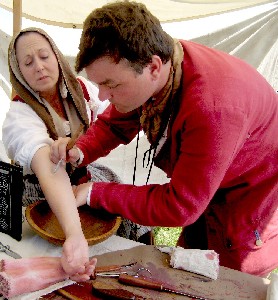
Photo: Jessica Bagley
Your author preparing to bleed a patient
bleed out naturally, in the same way that some surgeons felt that a diarrhea was an effective purge of bad humors from the body as explained earlier. Indeed, military Surgeon Raymund Minderer suggests that the surgeon "take heed of not stopping too suddenly the Bloody Flux, or any other Laske [flux]; for if you do, the annoyance will remain in the Body, and cause Impostumes, Difficulty of breathing, and other dangerous Distempers. Wherefore consult with thy strength, and if that be considerable, make not too much hast[e]; yet keep a bridle upon it, so as to be able to stop it when there is need."9
However, John Moyle suggests a specific reason for heroic bleeding, other than just to remove the impure humors contained in the blood. As he tells it, bleeding "lessens its [the blood's] quantity, and withal makes excellent revulsion [draws the blood away from the part affected which attracts the bad humors]"10. Cockburn agrees, explaining that in the bloody flux the only "Power it [bleeding] sometimes has in making a Revulsion and in changing the Coherence of Blood, whereby bleeding can any ways be useful in a Dysentery."11 Still, Cockburn goes on to note that "bleeding is very rarely the Cure of a Dysentery; as we find its Success very rarely mentioned, and observed."12
1 William Cockburn, The Nature and Cure of Fluxes, p. 135; 2 Cockburn, p. 286; 3 James White, De recta sanguinis miffione: OR, New and Exact Observations OF FEVERS, p.9-10; 4 John Woodall, the surgions mate, p. 207; 5 John Moyle, The Sea Chirurgeon, p. 175; 6 Moyle, ibid.; 7 Woodall, p. 216; 8 Woodall, p. 210-1; 9 Raymund Minderer, A Body of Military Medicines Experimented, Volume 4 of Paul Barbette's, Thesaurus Chirurgiæ, The Fourth Edition, p. 72; 10 Moyle, ibid.; 11 Cockburn, p. 302; 12 Ibid.
Treatment of a Flux: Clysters or Enemas
Although physicians and surgeons during the golden age of piracy were cautious about recommending bleeding for patients with fluxes, they were most enthusiastic about another form of humoral healing - the clyster.
In detailing a remedy for for diarrhea, physician William Cockburn informed his readers that "A Clyster is to be

Artist: Jean-Antoine Watteau
The Man With The Cyster Syringe, ein Mann mit
langem Haar und einer Klistierspritze
(1700)
given, in the Beginnings once or twice every Day."1 His reasoning is that "we must purge (as there is occasion) though the Diarrhœa is very great, because it has been found, that a Diarrhœa has ceased, after its Cause has been evacuated, and carried off."2 He further explains that in a diarrhea "Physicians have recommended purging Clysters, and sometimes Clysters that do not purge nor bind... Both these Sorts of Clysters are of excellent Use, when either the Sick are so weak that they cannot bear any purging Medicine of another Sort [such as emetics used to cause vomiting], or, that their weakly Condition calls for a sore speedy Preparative"3.
Sea surgeon John Woodall tells his readers that "glisters [clysters or enemas] of milke and egges onely are very good to swage gripings and paines"4. Military surgeon Raymund Minderer likewise recommends that "Clysters [are] of great benefit in Diseases of the bowels; ...I cannot but recommend them in this Distemper Clysters of Milk, wherein Pebble-stones have been several times quenched, mixing a little of the melted Suet of a Stag or Hind, without any Oyl or other fat."5
Minderer gives another milk and pebble clyster recipe, advising the use of "new Milk with its Cream on it, quench therein divers times red-hot Pebble-stones, so that the milk may grow hot of it; then mix with it two or three well-beaten Yolks of Eggs, two ounces of Sugar, melting in it an ounce and an half of Suet of a Deer or Stagg, and about half an ounce of Album-græcum [the dung of dogs or hyenas that has become white through exposure to air], using it for a Clyster, which cleaneth and healeth the Guts, and allays the sharpness of the Blood and other corrosive humors, that annoy the Bowels."6
Minderer gives great detail as to why such clysters work, providing insight into humoral theory in this case. He reasons "that the Milk washes the bowels, and clears them of sharp humors that annoy them; moreover, it is healing and repairing, by reason of the Pebbles quenched therein. The Sugar is abstersive, and helps to clean the injured places. The fat sticks to the parts annoyed, to defend them from being further hurt by the subsequent humors, which running down over it, can find no stay there, and consequently cause no more hurt to those parts."7 Her further advises that if the reader wants a "Clyster yet milder and more sanative, you may beat a yolk or two of new-laid Eggs, and mix them with it; though I have contented my self with the Ingredients before mention'd, and found great benefit thereby."8
However, Minderer warns his readers not to "put in any greasie Fat, or any Oyl of Olives, because they hinder healing; and all Oyl, except that of Linseed,
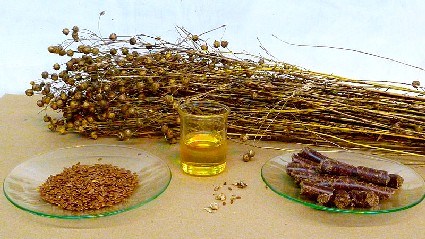
Photo: Handwerker
From Flax to Linseed Oil - Flax seeds (left), Cold-pressed cakes (right)
Poppies, Hemp and Almonds, is very sharp"9. You may recall from some of Cockburn's comments in previous sections that sharpness was believed to be one of the things that irritated the bowels and caused a diarrhea.
Cockburn is likewise in favor of using clysters for a dysentery, hearkening again to the advice of the ancients. "Hippocrates advises us to wash the Bowels with boiled Milk. Celsus says, we should give Clysters of a good Decoction of Barley; or Clysters of Milk; of melted Butter; or of Deer's Marrow: Oil-Clysters likewise are commended; Butter with Roses, and with it Whites of Eggs, or a Decoction of Linseed."10 He notes that the reason that ancients did this was to "wash the Rectum, and carry off the Stimulus, without the Sick risking any thing in their Life, and Strength."11

Photographer: Bouba
Flowers of Pomegranate
At sea, our two surgeons also recommended clysters for a bloody flux. John Woodall advised using "a glister with a decoction of dry Sentaury [Centaurium erythraea], Hipercon [St. John's Wort], Worme-wood or Balme, with Barley adding of Deere suet {2 ounces} and a little dried Galls in powder or cut in slices, or succus acatiæ or Cortices granatorum, or dried red roses, if you have them, of Balausties, which are flowers of Pomegranets: Note what powders soever you give in glisters, let them bee exceeding finely powdered, otherwise they are very dangerous"12.
John Moyle suggested that "Ulcerations of the Guts require to be healed by agglutinative and astringing Clysters."13 He recommends a barley water clyster containing shavings of stag's horn, rose oil and Myrtles. "Let this be administred warm and often, and the Patient will find the benefit of it, by healing of the Bowels, consolidating the Ulcers [in the intestines], and easing the sharp and cruciating pain."14
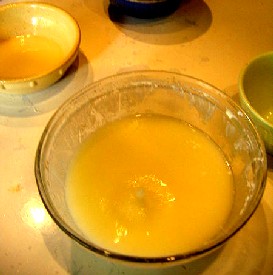
Photo: Jason Riedy
Whey From Making Goat's Milk Cheese
Cockburn is a fan of whey clysters. He credits this treatment to Flemish physician Herman Vander-Heyden and Thomas Sydenham. Sydenham advised that whey clysters were "to be injected warm, without Sugar or any other thing. I found the Gripes [pains in the bowels] and the bloody Stools went off with the fourth Glister. This Business being done, and all the Whey ejected, (which might be done in the space of two or three hours, if the Sick minded his business) I presently order'd him to go to bed, where he soon sweat of his own accord"15.
Cockburn testifies that the four clyster treatment worked, citing an example of a patient who failed to respond to 'a great Variety of Medicines' prescribed by other physicians. After following Sydenham's prescription, the patient "sweat plentifully, but had no bloody Stool after the first Clyster. His Griping went off, and his Loosness entirely ceased in twenty four Hours. Thus impending Death was prevented by this easy Method, and the sick Person, in some Weeks, recovered his Strength."16
1 William Cockburn, The Nature and Cure of Fluxes, p. 100; 2 Cockburn, ibid.; 3 Cockburn, p. 115; 4 John Woodall, the surgions mate, p. 210; 5 Raymund Minderer, A Body of Military Medicines Experimented, Volume 4 of Paul Barbette's, Thesaurus Chirurgiæ, The Fourth Edition, p. 75; 6 Minderer, p. 71; 7 Minderer, p. 76; 8 Minderer, p. 77; 9 Minderer, p. 76; 10 Cockburn, p. 289-90; 11 Cockburn, p. 289; 12 Woodall, p. 208; 13 John Moyle, The Sea Chirurgeon, p. 177; 14 Moyle, p. 177-8; 15 Thomas Sydenham, The Whole Works of that Excellent Practical Physician Dr. Thomas Sydenham, 10th Edition, p. 124; 16 Cockburn, p. 308

